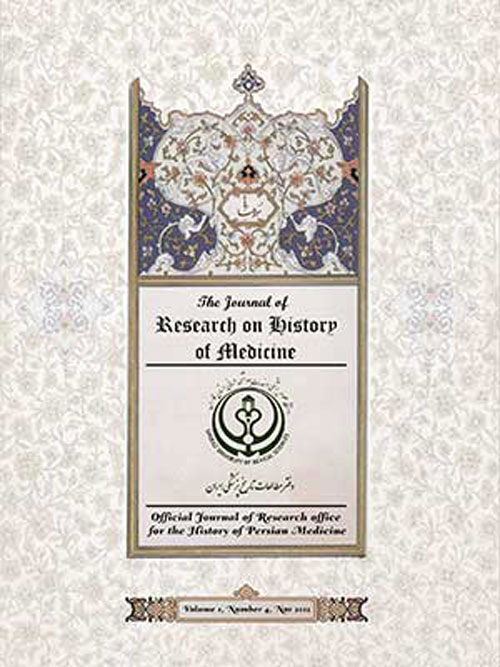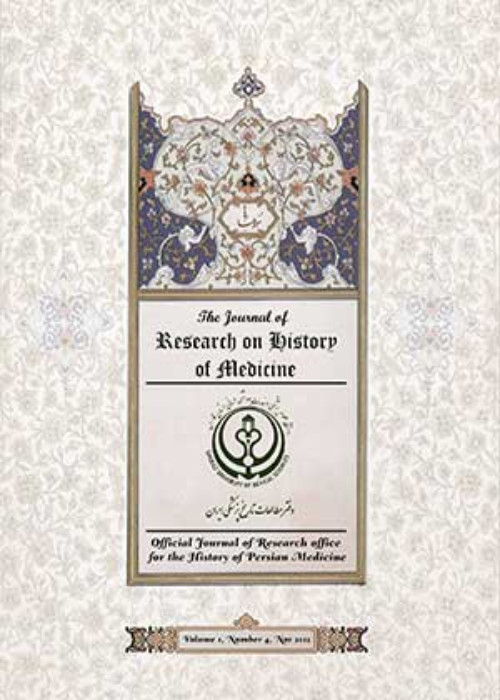فهرست مطالب

Journal of Research on History of Medicine
Volume:8 Issue: 4, Nov 2019
- تاریخ انتشار: 1398/08/10
- تعداد عناوین: 8
-
-
Pages 203-212As “Darolelm1”, Shiraz has always been a pioneer in various fields of knowledge including medical sciences. The physicians of this city have played an important role in advancing medical sciences since the fourth century AH and especially in the Buyid period. The medical knowledge in Shiraz continued its life from the Buyid period to the Safavid period but declined with the Afghan invasion and the fall of the Safavid government. After the Afghan rule, even with the coming to power of the Afsharid government, medical knowledge could not be restored and the eminent physicians of Shiraz migrated to India due to the welcoming of the Indian rulers. Although Karim Khan Zand tried to improve the economic and social conditions of Shiraz, conflicts in various parts of the country led to the of medical knowledge. In general, the prevalence of various diseases (to which many factors contributed), such as cholera, plague, and syphilis, indicated the decline of medical knowledge in this period. Using a descriptive approach along with the analysis and collection of data based on a library method, the current research examines medical knowledge with an emphasis on the diseases of people in Shiraz and the efforts of Shirazi physicians during the Afsharid and Zand periods to cure these diseases.Keywords: Afsharid, Zand, Shiraz, Disease, Cholera, Smallpox
-
Pages 213-228
During the early centuries of Islam, owing to the familiarity of Muslim scholars and practitioners with other civilizations and, in particular, their familiarity with different branches of science and medicine practiced by other nations, including Greek, Roman, Syrian, Indian and Iranian, as well as the translation of medical texts, medical science flourished among Muslims. Along with the growth of medical knowledge and its role in the development of Islamic society, Islamic physicians paid special attention to the specialization of this knowledge, including the field of obstetrics and gynecology science, leading to its significant development.From the third through the ninth century, the time period focused on in this study, Muslim doctors devoted most parts of their medical books to the field of obstetrics and gynecology, and some wrote treatises on this field. Issues such as the cause(s) of infertility in men and women and their treatment, the reasons for prohibiting pregnancy, methods of unwanted pregnancy prevention, abortion and abortion prevention methods, pregnancy diagnosis and methods of contraception are found profusely in their books. Hence, the present study aims to investigate the medical books written by Muslim physicians in the field of contraception and pregnancy prevention methods to find out whether physicians during the Islamic era pay attention to methods of contraception and pregnancy prevention. In addition, it is to see what encouraged them to practice this, what approaches they took and how successful they were. To address these issues, the researchers have focused on the following hypotheses: What methods have Muslim physicians adopted for the purpose of contraceptive methods and pregnancy prohibition: 1) preventive measures for men; 2) preventive measures for women, 3) pregnancy prohibition for both men and women.It is hoped that findings of this research, while addressing the above hypotheses, will demonstrate some of the achievements of Muslim doctors, such as prescribing medications for permanent infertility, oral contraceptive pills, or medications affecting infertility for certain time and diets recommended before intercourse for decreasing fertility.Having reviewed original manuscripts, including old medical textbooks, the method adopted in this research is that of descriptive-analytical based on library study.
Keywords: Pregnancy, infertility, Muslim physicians, Medical history, Prevention, Traditional medicine -
Pages 229-236Uterus cancer is one of the women’s diseases clinically diagnosed by some Muslim physicians. These physicians wrote about the symptoms, the effects of this disease on infertility or damage to the fetus, as well as some treatments, including surgery for this disease. The present study is aimed at focusing on this disease through presenting a descriptive-comparative method and the breakthroughs of the prominent Muslim physicians in the diagnosis of cancerous lumps of uterus, the characteristics of these lumps as being benign or malignant, the incurability of this disease in the case of the spreading growth of the tumor and the clinical effects of this disease.Keywords: Uterine Neoplasms, Female, infertility, Avicenna, Ali Ibn sahl Rabbn al-Tabari, Ali Ibn Abbas Majoosi, Razi
-
Pages 237-252The present article is concerned with those stories of Masnavi which contain medical and therapeutic points. To this end, the authors examined all Masnavi stories and extracted therapeutic and medical motifs from them. These statements, regardless of the name of the speaker, are like prescriptions of a physician. It is found that Rumi (Mawlana) has been familiar with medical concepts, using medical and therapeutic propositions to communicate his meanings; in the selected stories of Masnavi, the poet appears as a doctor and elaborates on physical and, mostly, on psychological illnesses and their treatments. In some stories of Masnavi, the main character is involved in a physical or mental illness that has been treated by a medical or spiritual physician.Keywords: Physicians, Names, Masnavi-ye-Ma’navi, Mawlana (Rumi), Motif, Treatment Routine, Spiritualism
-
Pages 253-260Maybe it can be said that Shiraz Medical School has been one of the oldest medical school in Iran which has remained rather neglected. The traces of such a claim can, at times, be found in the books and works left from the ancestors. The book “Chahar Maghaleh” or Four Discourses, written by Nizami Aruzi Samarqandi, is one of the books left from the 6th century AH. The book contains some reports on poets, astronomers, secretaries and physicians. One of these anecdotes is about a skilled physician from Fars province: Shiraz, confirming the existence of a medical school in this region. Using library research, the researchers of this study have made an effort to verify this claim.Keywords: History of medicine, Shiraz, Chahar Maghaleh of Nizami, Medical Schools, Literature
-
Pages 261-264A criterion for measuring the level of human health in societies is life expectancy. However, this quantitative index seems to be a way to theoretical and practical mysticism. The paradoxical thinking of death and happiness, the hope of living while thinking of a certain death in theology has a long history. The index of life expectancy is empirical, quantitative and logical and gives meaning to life. A person comes from submission, obedience and acceptance and is promoted to the level of passion and happiness.Keywords: Life expectancy, Mysticism, Qur’an, Meaning of life, Death, Happiness


